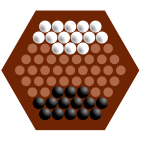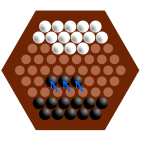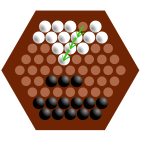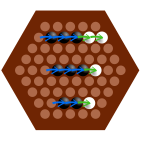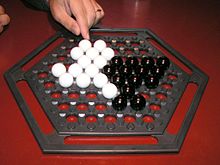Abalone (game)
| Abalone | |
|---|---|
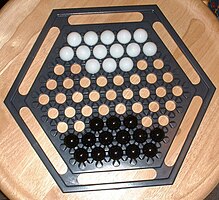 Standard basic position |
|
| Game data | |
| author |
Michel Lalet , Laurent Lévi |
| publishing company | Abalone Games (1988), Parker Brothers / Hasbro (1997), et al. a. |
| Publishing year | 1988 |
| Art | Strategy game |
| Teammates | 2 (in variants up to 6) |
| Duration | 30-45 minutes |
| Age | from 8 years
|
| Awards | |
|
Super As d'Or 1989 |
|
Abalone is a board game for two people that was developed by French game authors Michel Lalet and Laurent Lévi in 1987. Abalone won the Concours International de Créateurs de Jeux de Société in 1988 and in the same year it was published by Abalone Games . The game is now distributed internationally by various publishers, since 1997 by Hasbro under the Parker Brothers label . It received the Super As d'Or in 1989, was on the shortlist for Game of the Year 1989 and was selected as one of five games at the Mensa Select Mind Games 1990. In 1998 it received the As d'Or as "Game of the Decade".
Game description
Abalone is played on a hexagonal playing field with 61 gaps . 14 white and black balls are placed on the edge . By tactically moving one, two or three of your own balls you must try to push the opposing balls off the playing field. If you have thrown six opposing balls out of the field, you win.
initial position
A wide variety of basic positions are possible. The standard basic position is usually played at the beginning, as it leads to less complex positions. In the standard basic position, 14 balls of each player face each other. There are five balls in the first row, six balls in the second row and three balls in the middle of the third row. The players take turns, with Black always starting.
On these pictures it becomes clear that both players aim from the beginning to put pressure on the center and to fill it with as many balls as possible: Both players pull three balls each into the middle of the board. Usually, the attractive black succeeds in first occupying the central midfield. Characteristic of the standard game, especially in the opening phase, is the block game, in which the two opposing blocks attack each other.
However, since September 9, 1999, the Abalone Mind Sport Olympiad has been held with the basic position “Belgian daisy”. This basic position leads to more complex positions. The block position typical for the standard basic position in and after the opening is not possible here and a defensive style of play is not successful. In addition, Black does not manage to occupy the central midfield relatively stable in three moves, as in the standard line-up.
In addition to Belgian daisy and Standard, other basic positions (German daisy, Dutch daisy, Swiss daisy, Alien, Fujiyama, Snakes variant, Infiltration, Domination etc.) are played on the “Netabalone server”.
Trains
You can push the balls into all six directly adjacent gaps. It is possible to move one, two or three balls as long as the balls are moved in one direction (also diagonally ) and all adjacent gaps are free. Only one movement around a gap is allowed per turn.
Pushing opposing balls
If the field is occupied by an opposing ball, it can only be displaced from there by several own balls in a line if there is a free field behind it or the opposing ball is moved over the edge. This is called Sumito. There are three different sumitos:
- 2-1 Sumito: two own balls push an opponent's ball
- 3-1 Sumito: three own balls push one opponent's ball
- 3-2 Sumito: three own balls push two opposing balls
If the opponent has gathered three or more balls in a row, you cannot move them, nor do more than three of your own balls count, as you can only move a maximum of three balls at the same time. If there are equal numbers of own and opposing balls facing each other, one speaks of a draw .
target
The aim of the game is to push as many opposing balls as possible over the edge of the field. These balls are then out of play. Whoever pushed out six opposing balls first wins.
notation
As in chess, there is also a notation system for moves in abalone . The transverse lines are designated with letters from A to I (black base line is A) and the diagonals from 1 to 9 (left black diagonal is 1).
I O O O O O
H O O O O O O
G · · O O O · ·
F · · · · · · · ·
E · · · · · · · · ·
D · · · · · · · · 9
C · · X X X · · 8
B X X X X X X 7
A X X X X X 6
1 2 3 4 5
A move is marked with the start and end point of the last moving stone. A diagonal move is marked with the starting positions of the two outermost stones and the end position of one of these two outermost stones (see above “Opening by Black”, “Second Move by White”).
If an opposing stone is pushed out, this is marked with an asterisk.
Official abalone competitions
The Abalone World Championship is part of the Thinking Sport Olympiad ; there won:
| year | winner | country |
|---|---|---|
| 1997 | Feel, Marc |
|
| 1998 | Hrabal, Vojtěch |
|
| 1999 | Schnider, Gert |
|
| 2000 | Schnider, Gert |
|
| 2001 | Fenner, Thomas |
|
| 2002 | Šťastna, Jan |
|
| 2003 | Nicolet, Stephane |
|
| 2004 | Borello, Alex |
|
| 2005 | Pearce, David M. |
|
| 2006 | Šťastna, Jan |
|
| 2007 | Frochot, Vincent |
|
| 2008 | Šťastna, Jan |
|
| 2009 | Pearce, David M. |
|
| 2010 | Frochot, Vincent |
|
| 2011 | Frochot, Vincent |
|
| 2012 | Pearce, David M. |
|
| 2013 | Pearce, David M. |
|
| 2014 | Fiorini, Nicolas |
|
| 2015 | Frochot, Vincent |
|
| 2016 | Frochot, Vincent |
|
| 2017 | Frochot, Vincent |
|
Gert Schnider and Thomas Fenner took part in the development of the Aba-Pro program. Marc Tastet was world champion in Othello in 1992 .
Official competitions are always played with a clock. Time limits of ten minutes per train are the rule here.
In France , the Fédération Française des Joueurs d'Abalone is committed to increasing the culture of games and competition. There are now three abalone clubs there.
Their official tournament rules state that the tournaments are to be played in the Swiss system . The opponent's balls pushed off the playing field are counted as points for the winner. The loser receives zero points. If there is a tie in points after a player has reached his time limit, his opponent can request a time bonus. This is calculated from the remaining time. If it is over two minutes, he receives one point, over three minutes two points ... over seven minutes, he receives six points. The same number of points will be deducted from the opponent. If there is still a tie after this procedure, both players receive zero points.
In 2003 an abalone competition was held in Graz as part of the 8th Computer Olympics, in which only two programs took part. Here the program "AbaPro" (T. Werner, Gert Schnider ) won over the program "Nacre" (P. Sommerlund).
Various online tournaments organized by the i-Abalone community were held several times a week on the Netabalone server. In 2008, a world championship was held here for the first time in a double-round round-robin tournament and a subsequent final tournament of the best two players - Alex Borello and Pierre Alfaro - of the round-robin tournament. Two Mind Sports Olympics abalone winners - Alex Borello (2004) and Vincent Frochot (2007) - also took part in the double-round tournament.
variants
There are numerous game variants. In addition to several game variants for two players, there are also multi-colored balls on offer, with which you can play with up to six different players. A structurally similar game is Akiba .
Web links
- Abalone in the Luding games database
- Abalone in the game database BoardGameGeek (English)
Individual evidence
- ↑ Abalone in the Luding games database
- ↑ abalone in the game database BoardGameGeek (English)
- ↑ Mind Sports Olympiad Abalone Results (English)
- ↑ Computer Olympiad 2003 ( Memento from September 25, 2008 in the Internet Archive ) at www.cs.unimaas.nl/ (Dutch)
- ↑ http://www.i-abalone.com/eng/Tournaments/2008_World_Championship/Ranking/ (link not available)
- ↑ Mind Sports Olympiad: Abalone 2004 ( Memento from June 3, 2008 in the Internet Archive ) at msoworld.com (English)
